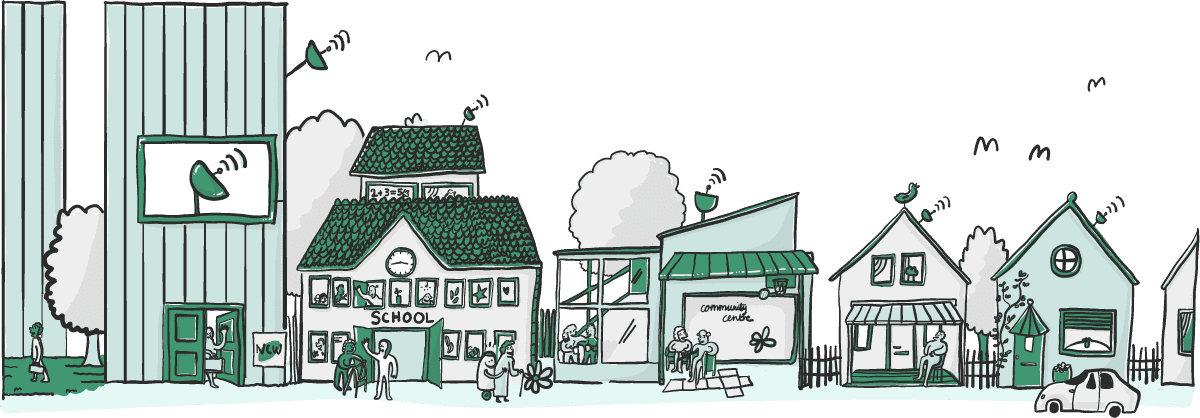Communities reap the benefit of the huge levels of additional money that was injected into the sector during the 2020s. In part, this funding was used to support a national drive to reinvent, re-energize and reimagine community development work, fit for the 2030s.
With a raft of ‘Inclusion as Prevention’ (IaP) projects around the country the evidence is clear that involving and including young people in decisions about their own lives reduces the likelihood of them entering the youth and criminal justice system.

A large amount of the 2020s investment was spent providing additional support for children within mainstream schools, ensuring that resources were available to include every child - regardless of ability or needs - within a mainstream school.

The Department for Education’s ‘Every Child is an Individual’ report of 2025 was far-reaching in shaping educational reform around an inclusion agenda. Literally tens of thousands of people answered the call to work in schools with children in a variety of roles, meeting shortages in the educational sector and increasing the value, prestige and salaries of people working in school-related roles. The report also encouraged a cultural shift in schools, with a greater emphasis on pupil engagement in school decision-making. Two notable outcomes of pupil engagement were the re-design of schools to be fully accessible and conducive to their mental and physical health, and a reform of the curriculum, signifying a move from summative assessment (exams) to continuous, formative assessment (ongoing learning).

With every child receiving a tailored education experience, an overall reduction in stigma has been reported by young people, who may have otherwise faced discrimination. This cultural change, initiated by the systems-wide change to the sector, has meant that nearly all children now attend some form of education setting and every young person is now being guided into the world of work or further/higher education by caring adults - some of whom are professionals, and some of whom are volunteers.
Health colleagues work very closely with children's services and educational institutions through smart data systems, and that intelligence is used to tackle negative behaviours at an early stage, and through ‘inclusion as prevention’ measures.

Sustained public health campaigns to change the eating and drinking habits of young people (and their families), particularly in areas of deprivation, have shown great results. Children report being happier, with higher levels of physical and emotional wellbeing and lower reported rates of stress and mental ill-health.
Today in 2035, any professional or volunteer working with children and young people has, as part of their training, the expectation that the system is:
- Child-focused - it ensures any child or young person – and their family – is at the centre of decision-making about the support available to them.
- Based on an understanding of the wellbeing of a child in their current situation. It takes into consideration the wider influences on a child or young person and their developmental needs when thinking about their wellbeing so that the right support can be offered.
- Based on tackling needs early - it aims to ensure needs are identified as early as possible to avoid bigger concerns or problems developing.
- Focused on prevention - so that children and young people (and their families) stay well and understand how to be healthy and happy, thereby reducing physical and mental ill-health and avoiding potentially damaging behaviours.
- Underpinned by joined-up working - it is about children, young people, parents, and the services they need - all working together in a coordinated way to meet the specific needs of the individual and improve their overall wellbeing.
The children’s professional workforce has worked hard to ensure all children and young people receive the right help, at the right time, from the right people. This has led to young people growing up feeling loved, safe and respected so that they can realise their full potential. Our system ensures children who need it get extra help, and it means families work in partnership with those who can support them through strong, trust-based relationships, such as teachers, doctors, social workers and nurses.

Children with disabilities or special education needs are provided with tailored support and the tools to integrate into mainstream education. More staff have been employed to specifically support children with additional support needs, while all teachers undergo extensive, ongoing training in how to support children of different needs, challenges and abilities. Schools now have the time, resources, training and motivation to ensure that the individual needs of every child are met. School buildings and spaces have been redesigned through a ‘disability lens’, including wheelchair- and crutches-friendly access to all rooms and spaces, and ‘calm rooms’ for those children who need regular mental health breaks.
Children and young people who have other equalities characteristics - based on race, ethnicity, gender, sexual orientation, ability, or religion - have their rights respected and their needs accounted for. The children’s workforce of professionals are better able to anticipate and identify any potential problems, barriers or discrimination that children with equalities characteristics may face at school, at home or in the community. As children’s services are fully integrated with other services - such as health education - they are able to work together effectively to minimise any negative consequences of discrimination (such as homophobia, racism, ableism, sexism, xenophobia) and support the wellbeing and resilience of children in dealing with these issues. A government drive to ensure policy coherence around inter-sectional equalities issues has further resulted in positive outcomes for children and young people.

The higher education sector has expanded its ‘widening participation’ portfolio, which has now become a statutory requirement of state-funded universities, and has seen increasing numbers of young people from disadvantaged and less-privileged backgrounds entering university. Tuition fees were scrapped in 2028, in response to spiralling levels of student debt, which further opened the doors of universities to families with less income. With the further education sector proving to be less nimble in coping with the demands of the market and many colleges closed, however the network of vocational learning centres that replaced them in 2025 is continuing to perform well a decade on.
Young people entering the labour market are better-prepared, better-supported, more confident, and more qualified to embark on successful careers of their choosing. As children’s services operate in a holistic way, this has encouraged joined-up working between schools, further/higher education institutions and employment agencies - encouraging a more seamless transition and blurring of the lines between education to employment. There are always people at every step mentoring children and young people along their post-education pathway.
In the labour market generally, there has been a curtailment of working practices that led to job insecurity in recent years, including the abolition of zero-hours contracts. More and more school-leavers and graduates are able to directly enter permanent employment. Technology has had an important impact on the labour market, which most children and young people are prepared for through their education and learning experiences. The government has also introduced a Social Insurance Scheme to support workers into new jobs affected by AI - so parents (with benefits to their families) are re-trained within the labour market.

Today, in part through government funding, young people leaving home are fully supported to move into social housing, enhancing their independence and confidence. Homelessness has rapidly fallen in recent years. As the Chief Executive of Shelter said last month, when opening a new complex of low-cost housing for former homeless people, “the private housing market bubble has finally burst as new, low-cost housing is introduced to the market, and housing becomes more affordable for all with smart design.”

Technology continues to enable transformation in many areas of life. Virtual personal assistants for older people, voice-activated technology, wearable technology, personal development apps all play their part. Families can access more services online. Augmented reality and AI have also made children’s and young people’s learning experiences in schools, colleges, universities more interactive and accessible.
Despite many years of professionals saying it could not be done, the children’s workforce of today benefits from years of investment into data-sharing systems, to enable them to integrate data from different service providers, to create comprehensive datasets on individuals and families, enabling them to create accurate needs assessments.
Computer-driven systems work with big data and algorithms to make predictions about where needs may emerge, and what the effects of different interventions might be.

Finally, in 2027, 5G broadband was extended to every household in England, which has enabled children’s services to use digital technology more effectively, and it has also empowered families from all backgrounds to connect, learn, and work more effectively and flexibly. The unintended negative consequences of technology (potential for exclusion, inaccessibility, ethical issues) have thus been mitigated.
Regional devolution has effectively transferred power to a level ‘closer to the people’ and regional assemblies have provided a new layer of democracy for people to participate. Regional devolution allows politicians and policy-makers to respond more effectively to the needs of regional populations and economies.

Over the years, regional executives have accumulated more and more powers from local authorities, especially in the areas of health, education and housing. Some people have welcomed this, saying that it allows for the standardisation of services across local communities. However, others have criticised the regional concentration of powers as disempowering local communities and creating the potential for a ‘race to the bottom’ mentality of reducing tax rates and de-regulating business.

Local communities themselves are ‘surviving but not thriving’ as the Chair of the Citizens Advice Bureau pointed out in their Annual Report this year. Regional assemblies have taken over many powers that councils used to exercise, and do not engage as extensively with community groups as the councils used to. Local community and voluntary groups therefore have less voice in decision-making over local issues. This has been partly offset by the efforts of national and regionally devolved services to include community organisations in ‘joined-up’ approaches to children’s services, such as creating stronger links between schools and communities. Third sector and community organisations have also benefited from a change in public procurement practices, which has created more opportunities for collaborative commissioning and reduced the competitive drive for funding.

